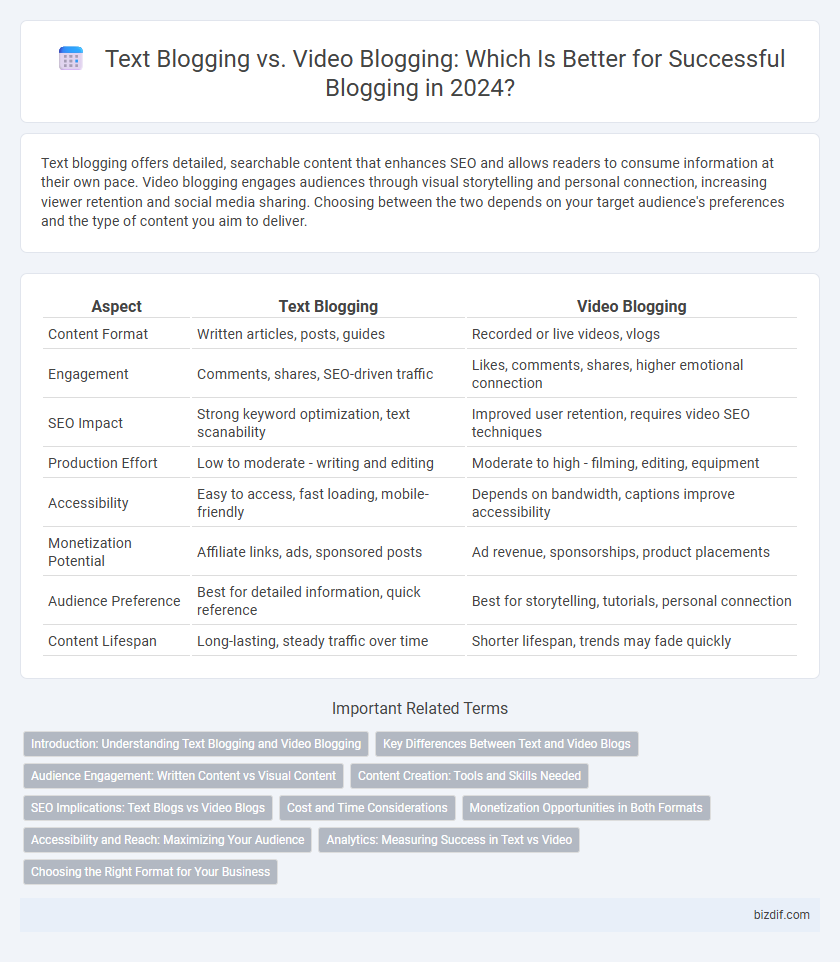Text blogging offers detailed, searchable content that enhances SEO and allows readers to consume information at their own pace. Video blogging engages audiences through visual storytelling and personal connection, increasing viewer retention and social media sharing. Choosing between the two depends on your target audience's preferences and the type of content you aim to deliver.
Table of Comparison
| Aspect | Text Blogging | Video Blogging |
|---|---|---|
| Content Format | Written articles, posts, guides | Recorded or live videos, vlogs |
| Engagement | Comments, shares, SEO-driven traffic | Likes, comments, shares, higher emotional connection |
| SEO Impact | Strong keyword optimization, text scanability | Improved user retention, requires video SEO techniques |
| Production Effort | Low to moderate - writing and editing | Moderate to high - filming, editing, equipment |
| Accessibility | Easy to access, fast loading, mobile-friendly | Depends on bandwidth, captions improve accessibility |
| Monetization Potential | Affiliate links, ads, sponsored posts | Ad revenue, sponsorships, product placements |
| Audience Preference | Best for detailed information, quick reference | Best for storytelling, tutorials, personal connection |
| Content Lifespan | Long-lasting, steady traffic over time | Shorter lifespan, trends may fade quickly |
Introduction: Understanding Text Blogging and Video Blogging
Text blogging involves creating written content that is searchable, easily scannable, and optimized for SEO, allowing bloggers to target specific keywords and attract organic traffic. Video blogging, or vlogging, leverages visual and auditory elements to engage audiences, enhance storytelling, and improve retention rates on platforms like YouTube and social media. Both formats require tailored strategies for content creation, audience engagement, and platform optimization to maximize reach and impact.
Key Differences Between Text and Video Blogs
Text blogging emphasizes detailed written content that enhances SEO through keyword integration and allows for easy skimming and reference, while video blogging leverages visual and auditory engagement to capture audience emotions and boost viewer retention. Text blogs are ideal for in-depth tutorials, analysis, and content that requires quick updates, whereas video blogs excel in storytelling, demonstrations, and building personal connections via facial expressions and tone. The choice between text and video blogging depends on content goals, target audience preferences, and platform algorithms that influence content discoverability and interaction rates.
Audience Engagement: Written Content vs Visual Content
Text blogging offers deep, detailed content that attracts readers seeking comprehensive information and supports SEO through keyword-rich writing, enhancing discoverability. Video blogging engages audiences with dynamic visuals and audio, fostering emotional connections and higher retention rates, especially on social media platforms. Balancing written and visual content maximizes audience engagement by catering to diverse preferences and learning styles.
Content Creation: Tools and Skills Needed
Text blogging requires proficiency in writing, SEO strategies, and content management systems like WordPress or Medium to effectively create and optimize articles for search engines. Video blogging demands skills in video shooting, editing using software such as Adobe Premiere Pro or Final Cut Pro, and a good understanding of audio quality and lighting to produce engaging visual content. Both formats benefit from research tools, audience analysis, and consistent content planning to enhance reach and engagement.
SEO Implications: Text Blogs vs Video Blogs
Text blogging offers superior SEO advantages due to its rich keyword integration, metadata optimization, and easier indexing by search engines, boosting organic traffic. Video blogging enhances user engagement and dwell time, which indirectly supports SEO but requires detailed transcripts and optimized descriptions to maximize search visibility. Combining both formats strategically leverages the strengths of text for keyword ranking and video for higher engagement metrics.
Cost and Time Considerations
Text blogging requires lower upfront costs with basic tools like a computer and internet access, making it more affordable for beginners, while video blogging demands significant investment in cameras, editing software, and lighting equipment. Time efficiency favors text blogging as writing and publishing articles typically take less time than scripting, filming, and editing videos. Budget-conscious creators often choose text blogging to maximize content output without the extended time commitments and higher expenses associated with video production.
Monetization Opportunities in Both Formats
Text blogging offers diverse monetization options such as display ads, affiliate marketing, sponsored content, and direct product sales, benefiting from strong SEO potential that drives organic traffic. Video blogging leverages platforms like YouTube and Twitch, enabling income through ad revenue, channel memberships, super chats, and brand partnerships, with higher engagement rates that often translate to increased sponsorship deals. Both formats require strategic audience targeting and consistent content creation to maximize earning potential in competitive digital markets.
Accessibility and Reach: Maximizing Your Audience
Text blogging offers enhanced accessibility by allowing users with limited internet bandwidth or older devices to consume content easily, while search engines efficiently index written posts, boosting organic reach. Video blogging engages audiences through dynamic visuals and audio, appealing to viewers who prefer multimedia formats, but may face barriers due to slower loading times and device compatibility. Combining text and video content strategically maximizes audience reach by catering to diverse user preferences and accessibility needs.
Analytics: Measuring Success in Text vs Video
Text blogging offers detailed insights through metrics like page views, average time on page, bounce rates, and keyword rankings, enabling precise SEO performance tracking. Video blogging analytics emphasize viewer engagement metrics such as watch time, retention rate, click-through rate, and social shares, providing a clearer picture of audience interaction and content impact. Comparing these data sets helps marketers optimize content strategies by understanding whether readers prefer in-depth reading or dynamic visual storytelling.
Choosing the Right Format for Your Business
Selecting the right format for your business hinges on your target audience's preferences and your content goals. Text blogging excels in SEO benefits, providing detailed, keyword-rich articles that boost search engine rankings and long-term traffic growth. Video blogging engages audiences through visual storytelling, increasing viewer retention and social media shares, making it ideal for brand personality and product demonstrations.
Text Blogging vs Video Blogging Infographic

 bizdif.com
bizdif.com